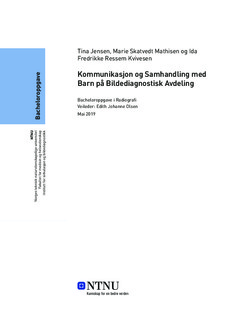| dc.contributor.advisor | Olsen, Edith Johanne | |
| dc.contributor.author | Jensen, Tina | |
| dc.contributor.author | Mathisen, Marie Skatvedt | |
| dc.contributor.author | Kvivesen, Ida Fredrikke Ressem | |
| dc.date.accessioned | 2019-09-06T14:03:00Z | |
| dc.date.available | 2019-09-06T14:03:00Z | |
| dc.date.issued | 2019 | |
| dc.identifier.uri | http://hdl.handle.net/11250/2613227 | |
| dc.description.abstract | Hensikt med oppgaven:
God kommunikasjon og god samhandling er viktige faktorer for radiografer når de har barn som pasienter. Barn har behov for en annen tilnærming enn voksne, da deres kognitive utvikling er på et annet nivå. Barneombudet utviklet i 2011 i samarbeid med barn “sykehusekspertenes 10 bud”. Disse punktene omhandler hvordan barn ønsker at det skal være, når de er pasienter på sykehus. Flere av punktene omhandler kommunikasjon. På bakgrunn av dette er det interessant å observere om de blir overholdt i praksis, og hvilke strategier som benyttes innenfor kommunikasjon og samhandling.
Metode:
Gjennom et observasjonsstudie har vi observert 6 radiografer som i hovedsak arbeider med barn som pasientgruppe. Vi har blant annet sett etter hvordan de tilpasser språk, informasjon og oppgaver til barnets alder. Det ble observert 30 undersøkelser på barn i alderen 4-12 år over en 3 ukers periode.
Resultat og Konklusjon:
Resultatet fra observasjonen viser at “sykehusekspertenes 10 bud” i stor grad ble overholdt i praksis. Radiografene som ble observert kommuniserte og samhandlet godt med barna, og tilpasset seg barnets alder. Noe som ble lagt merke til, og som strider i mot “sykehusekspertenes 10 bud”, er at garantier ble gitt i stor grad. Dette er noe sykehusekspertene ikke ønsker, og radiografene overholdte ikke dette punktet. | |
| dc.description.abstract | Background:
Good communication and good interactions are important factors for radiographers when they have children as patients. Children need a different approach than adults, as their cognitive development is at a different level. In 2011, “barneombudet” developed in collaboration with children "sykehusekspertenes 10 bud". These communicate how children want it to be when they are patients at the hospital. Several of the points deal with communication. On this basis, it is interesting to observe whether they are uphold in practice and which communication strategies are used.
Method:
Through an observation study, we have observed 6 radiographers who mainly work with children as a patient group. We have, among other things, looked at how they adapt language, information and tasks to the child's age. 30 examinations were observed in children aged 4-12 years over a 3-week period.
Results and Conclution:
The results of the observation show that “sykehusekspertenes 10 bud” were largely uphold in practice. The radiographers who were observed communicated and interacted well with the children, and adapted to the child's age. Something that was noticed and contrary to “sykehusekspertenes 10 bud” is that guarantees were given in a large extent. This is not what the children want, and the radiographers did not uphold this. | |
| dc.language | nob | |
| dc.publisher | NTNU | |
| dc.title | Kommunikasjon og Samhandling med Barn på Bildediagnostisk Avdeling | |
| dc.type | Bachelor thesis | |
